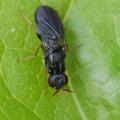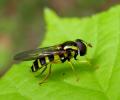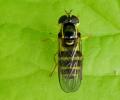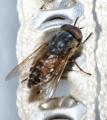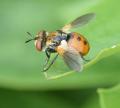Who is here? 1 guest(s)
|
Sarcophaga sp. ?
|
|
| Alvesgaspar |
Posted on 28-10-2007 00:33
|
|
Member Location: Posts: 571 Joined: 24.08.07 |
I think this is a female Sarcophagidae. Could it be Sarcophaga sp.? Contrarily to similar flies I see in this place, the tip of the abdomen is not redish. Thanks, Joaquim Gaspar |
|
|
|
| Alvesgaspar |
Posted on 28-10-2007 00:48
|
|
Member Location: Posts: 571 Joined: 24.08.07 |
Here is a detail of the head |
|
|
|
| ChrisR |
Posted on 28-10-2007 01:12
|
|
Administrator Location: Posts: 7699 Joined: 12.07.04 |
Although some genera in the tribe Sarcophagini have orange genitalia not all do - it's just one of many features that key out the different genera. Also, I think the orange genitalia only apply to males - females are usually (always?) black  Anyway, looks big - like a Sarcophaga sp. to me, but I'd need the specimen to be sure 
Edited by ChrisR on 28-10-2007 01:16 |
|
|
|
| pierred |
Posted on 28-10-2007 09:11
|
|
Member Location: Posts: 1413 Joined: 21.04.05 |
Chris Raper wrote: Also, I think the orange genitalia only apply to males - females are usually (always?) black  This picture shows that both of them have red genitalia: http://www.dipter...to_id=1735 Pierre Duhem |
|
|
|
| Zeegers |
Posted on 28-10-2007 10:17
|
|
Member Location: Posts: 18446 Joined: 21.07.04 |
And it's a male.... Sarcophaga ss. does not have orange genitalia, these are found in other 'genera' like Helicophagella. Theo |
|
|
|
| Alvesgaspar |
Posted on 28-10-2007 16:26
|
|
Member Location: Posts: 571 Joined: 24.08.07 |
Zeegers wrote: And it's a male.... Sarcophaga ss. does not have orange genitalia, these are found in other 'genera' like Helicophagella. Theo Thank you for the help, it appears I have landed in a difficult subject... How can one distinguish between a male and a female Sarcophagid? Edited by Alvesgaspar on 28-10-2007 16:27 |
|
|
|
| Zeegers |
Posted on 28-10-2007 17:10
|
|
Member Location: Posts: 18446 Joined: 21.07.04 |
IN most calyptrate flies (Sarcophagidae included), the female has a larger gap between the eyes with 2 additional pairs of proclinate setae (thus lacking in the male). Moreover, if the pulvilli are enlarged (as in the first pic), you have a male in front of you (however, vice versa is NOT true). There are exceptions. Theo |
|
|
|
| jorgemotalmeida |
Posted on 28-10-2007 17:39
|
|
Member Location: Posts: 9295 Joined: 05.06.06 |
Just for those who are reading and can be lost with the terms.  Calyptrate flies - those flies that have calypter - they belong to the Calyptratae ![header=[Calyptratae] body=[Calyptratae is a subsection of Schizophora in the insect order Diptera, commonly referred to as the calyptrate muscoids (or simply calyptrates). It consists of those flies which possess a calypter that covers the halteres, among which are some of the most familiar of all flies, such as the house fly.<br />
Links: Diptera classification (http://www.diptera.info/viewpage.php?page_id=17)<br /><img src='../infusions//terms/images/no_image.gif' style='vertical-align:middle;' />] delay=[0] fade=[on]](../infusions/terms/images/help.gif) . Calypter is located below the wings and usually with 2 pairs. . Calypter is located below the wings and usually with 2 pairs. The last tarsomere (=distitarsus) usually bears 2 claws (i never saw a fly with 3 claws.. garras in Portuguese) . Sometimes, the last tarsomere can have two pulvilli with an empodium in the middle. The pulvilli above have red colour. It is very clear in first photo at your left (1st and 2nd left legs). The empodium IS NOT visible in your photo. (it is located between the pulvilli). We would need more magnification to see that.  NOTE: Tarsus [the segment more apical of the leg - more near the ground  ] has 5 tarsomeres. The first tarsomere (more basal one - i.e. more near tibia than the ground) is called metatarsus=basitarsus; the last is called distitarsus (from distal). ] has 5 tarsomeres. The first tarsomere (more basal one - i.e. more near tibia than the ground) is called metatarsus=basitarsus; the last is called distitarsus (from distal).See here for: proclinate ![header=[proclinate] body=[bent forward (usually used to indicate curvature of setae)<br /><img src='../infusions//terms/images/no_image.gif' style='vertical-align:middle;' />] delay=[0] fade=[on]](../infusions/terms/images/help.gif) setae setae For setae see Overviews section for more information.  Specially this one: Specially this one: http://www.dipter...ad_id=8790 Edited by jorgemotalmeida on 28-10-2007 17:49 |
|
|
|
| Alvesgaspar |
Posted on 28-10-2007 19:02
|
|
Member Location: Posts: 571 Joined: 24.08.07 |
Thak you for the entomologic anatomy lesson. I'll need a couple of months from now to absorb all these new terms |
|
|
|
| Jump to Forum: |


